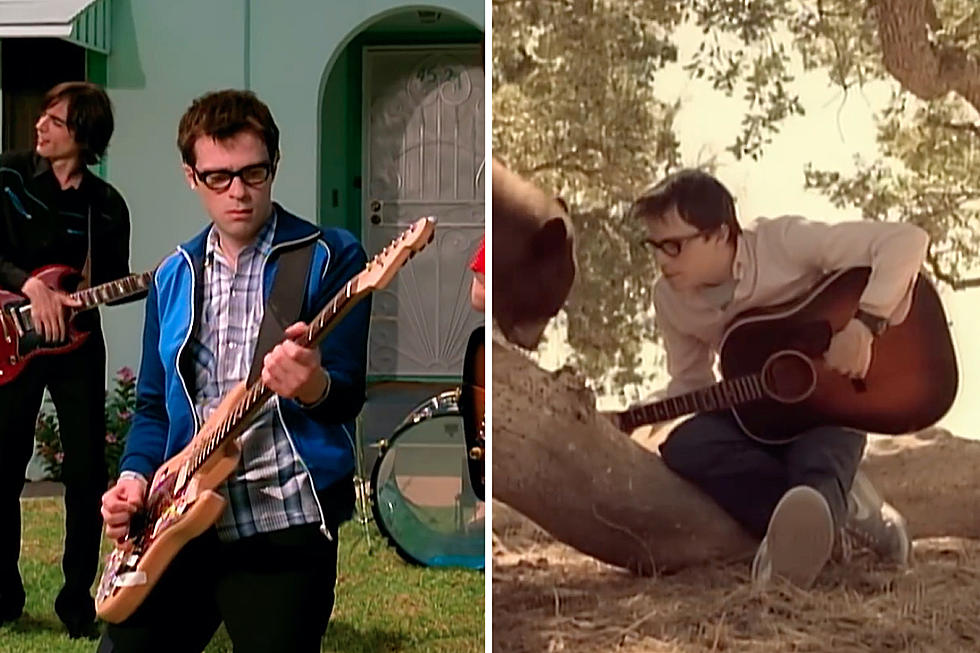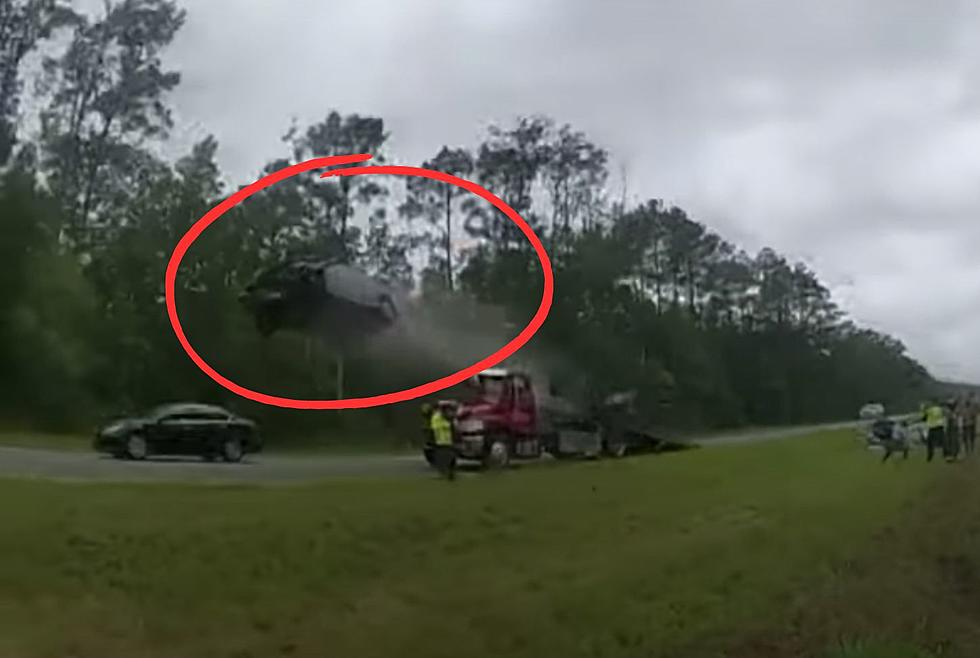![Flashback: Beatles Release ‘Abbey Road’ [VIDEO]](http://townsquare.media/site/486/files/2012/09/The-Beatles-19661.jpg?w=980&q=75)
Flashback: Beatles Release ‘Abbey Road’ [VIDEO]
It was 43 years ago today (September 26th, 1969) that the Beatles' final album, Abbey Road, was released. Although the Let It Be album was released the next year featuring earlier unreleased tracks, Abbey Road was the last album the group recorded together. The album's working title had been Everest -- after a brand of cigarettes their engineer Geoff Emerick smoked -- before the group simply chose the name of the street where their recording studio was located.
Abbey Road spent 11 weeks at Number One and featured the double A-sided single "Come Together" and "Something," the highest-charting Beatles song written by George Harrison. Paul McCartney commented on the song in The Beatles Anthology saying, "'Something' was out of left field. . . It appealed to me because it has a very beautiful melody. I thought it was George's greatest track."
The recent remaster of Abbey Road debuted in 2009 at Number One on Billboard's Pop Catalog chart. In January it was announced that for the third year in a row, Abbey Road remained the best selling vinyl album. According to the Nielsen/SoundScan list, Abbey Road sold an impressive 41,000 copies in 2011 beating out new vinyl releases from Wilco, Black Keys, Adele, and Fleet Foxes. Earlier this year, Ringo Starr told Rock Cellar magazine that Abbey Road was his favorite of the band's albums, explaining, "For me, that would be the second side of Abbey Road. That one is my favorite because I just love all those bits and pieces that weren't full songs that John (Lennon) and Paul (McCartney) had been working on and pulled all together -- 'Mean Mr. Mustard,' 'Polythene Pam,' and 'She Came In Through The Bathroom Window.'"
By the time of the Abbey Road sessions, which began in earnest in mid-1969, the group had been in the slow process of breaking up since their return from India the previous year, and struggled through 1968's "The White Album" as well as the month-long movie shoot that resulted in 1970's Let It Be album and film.
By the spring of 1969 John Lennon was drifting further away, after marrying Yoko Ono and embarking on the first of several anti-war "bed in" events.
Paul McCartney was eager that the group not end on the sour note that had become the Let It Be project, and rallied the group to produce an album on par with classics like Rubber Soul, Revolver, and Sgt. Pepper's Lonely Hearts Club Band.
The seeds for the Abbey Road album lay in the January 1969 Let It Be album and film project -- which was still unreleased when the Abbey Road sessions commenced. George Harrison recalled during The Beatles Anthology that it was actually the group's decision to better their work on Let It Be for their official followup to 1968's "The White Album": "Well, I think the deal was through Let It Be, it was like, I left, and we got back on the basis of we've gotta just finish it up and make it tidy, so I got back on that basis. Then everybody decided we ought to do one better album."
Producer George Martin recalled in The Beatles Anthology the events leading up to the mid-1969 sessions which kicked off Abbey Road: "At the end of Let It Be. . . Let It Be was such an unhappy record, really -- even though there are some great songs on it -- I really thought that was the end of the Beatles and I thought I would never work with them again. I thought, 'What a shame to go out like this.' So I was quite surprised when Paul rang me up and said, 'We're going to make another record, would you like to produce it?' And my immediate answer was -- 'Only if you let me produce it the way we used to.' And he said to me, ' We do want to do that.' I said, 'John included?'' He said 'Yes, honestly.' So I said, 'If you really want to do that, let's do it and get together again.' And it was a very happy record. I guess it was happy because everybody knew it was going to be the last."
Harrison admitted he wasn't sure whether the Abbey Road sessions were making the end of the Beatles: "We didn't know, or I didn't know, at the time that it was the last Beatle record that we would make, but it kind of felt a bit like we were reaching the end of the line."
McCartney remembers that the band was definitely out to prove something with Abbey Road: "I think it was, in a way, the feeling that it might be our last, so let's show 'em what we can do, let's show each other what we can do, let's have a good time doing it. We had lots and lots of bits and things. John had a bit of a song called 'Polythene Pam' and we hit upon the idea of medley-ing them all, which gave the second side of Abbey Road a kind of sort of operatic kind of structure -- which was kind of nice 'cause it got rid of these songs in good way."
Beatles author Bruce Spizer says that some of the credit for the aural quality of Abbey Road has to go to the Beatles' chief engineer and their producer: "Some of that obviously was due to the great techniques that Geoff Emerick and George Martin were putting forth on these, where, y'know, the Beatles wanted a certain sound, it was their job to somehow create it."
Beatlefan magazine executive editor Al Sussman believes that at the very least, the band realized they were at some type of crossroads, and that spurred them on to the height of their creativity: "I'm not sure that it absolutely is the best Beatles album -- but the last side of it may be the best side of music the Beatles ever put together as a band. I think they, even if it was subconsciously, realized that this was going to probably be their last album for at least some time to come -- they probably didn't realize it was going to be the last album forever, but I think they knew it was going to be the last album for some time to come. It's one of the miracles of the summer of '69, like the moon landing, like Woodstock, like the Mets."
From the opening funky groove of Lennon's "Come Together" to Harrison's classic ode to spring "Here Comes The Sun" to McCartney's mini-opera that dominated side two, the Beatles managed to put their personal and business differences aside to produce an album that rivaled, if not topped, their greatest work.
On August 20th, 1969 all four Beatles attended the album's final mix and running-order session. It was the last time all four Beatles were together in a recording studio.
'ABBEY ROAD' FAST FACTS
During the Abbey Road sessions Paul McCartney recorded a demo for "Come And Get It" featuring himself on piano, vocals, bass, drums and maracas -- all within an hour. The song was later recorded by Badfinger under McCartney's supervision. McCartney's demo was eventually released on 1997's Anthology 3 album.
John Lennon missed a block of sessions during July 1969 after he and Yoko -- along with their respective children, Julian Lennon and Kyoko Cox -- were involved in a car crash in Scotland. Upon their return, Lennon had a hospital bed installed in Abbey Road Studio Two for Yoko -- complete with a live microphone in case she wanted to make any suggestions.
Despite the array of signature Beatles harmonies throughout the album, John Lennon is not featured vocally on "Something," "Oh! Darling," "Octopus's Garden," "Here Comes The Sun," and "Golden Slumbers/Carry That Weight."
Lennon at one point suggested that all of his songs be placed on one side of the album, with McCartney's on the other.
Out of all the songs on Abbey Road only "Come Together," "Here Comes The Sun," "Because," "You Never Give Me Your Money," and 'The End" were not run through during the January 1969 Let It Be sessions.
In the original tracklisting for Abbey Road, the long medley, which closed the album, was originally slated to close Side One.
Lennon, McCartney, and Harrison play the three sparring guitar solos on "The End."
George Harrison plays bass on "Golden Slumbers/Carry That Weight."
Paul McCartney plays electric guitar on "Oh! Darling," "You Never Give Me Your Money," and "The End."
"Golden Slumbers" was based on a 17th century poem by Thomas Dekker. McCartney's stepsister Ruth asked him to play the sheet music at the family piano, McCartney, who can't read music, made up his own melody and later wrote his own song around these original lyrics:
Golden slumbers kiss your eyes,
Smiles awake you when you rise;
Sleep, pretty wantons, do not cry,
And I will sing a lullaby,
Rock them, rock them, lullaby.
Care is heavy, therefore sleep you,
You are care, and care must keep you;
Sleep, pretty wantons, do not cry,
And I will sing a lullaby,
Rock them, rock them, lullaby.
Abbey Road is the one-and-only Beatles album to feature the Moog synthesizer. Lennon added Moog to his "I Want You (She's So Heavy)," with McCartney adding synth to his own "Maxwell's Silver Hammer' and Harrison's "Here Comes The Sun."
Four George Harrison songs were demo-ed at Abbey Road studios on his 26th birthday -- February 25th, 1969; "All Things Must Pass," "Isn't It A Pity," "Old Brown Shoe," and "Something." Only "Something" was destined for Abbey Road. "Old Brown Shoe" was rerecorded and released that June as the B-side to "The Ballad Of John And Yoko," with "All Things Must Pass," and "Isn't It A Pity" both re-recorded and released on Harrison's first post-Beatles album, 1970's All Things Must Pass.
The recording studio Abbey Road was built in 1929 by the Beatles' British record label EMI and named EMI Recording Studios. It was only after the album's success that EMI formally changed the studio's name to "Abbey Road."
More From KYBB-FM / B102.7
![Watch This Guy Clear Snow With a Flamethrower [VIDEO]](http://townsquare.media/site/486/files/2024/01/attachment-Copy-of-Copy-of-Copy-of-Copy-of-Copy-of-copy-1.jpg?w=980&q=75)




![[WATCH] Mellow Grizzly Bear Stops and Sits Next To Photographer](http://townsquare.media/site/66/files/2023/05/attachment-Grizzly.jpg?w=980&q=75)


![Man Immediately Regrets Letting Crawfish Pinch His Nose [VIDEO]](http://townsquare.media/site/34/files/2023/03/attachment-Screen-Shot-2023-03-14-at-11.29.13-AM.jpg?w=980&q=75)
